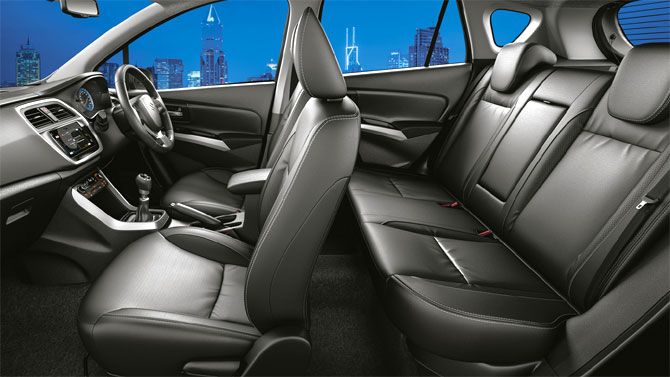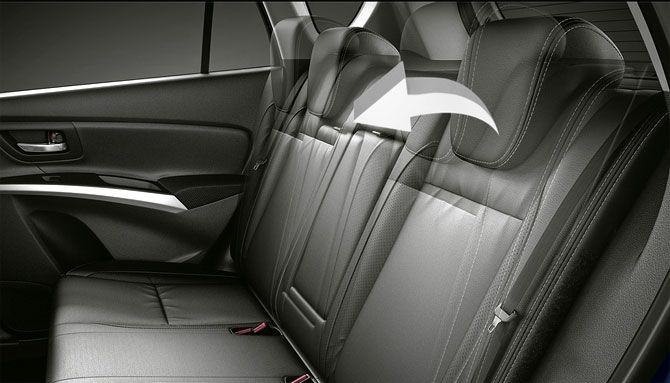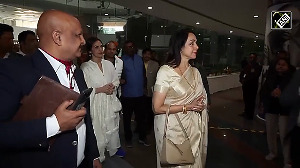S-Cross will be available only in diesel variants

Maruti Suzuki India’s absence in the compact SUV segment has been conspicuous ever since Renault pioneered with Duster back in 2012. Automakers in India have been vying to grab a pie of the growing popularity of this newly inducted segment, but MSI waited patiently until it was ready with the right product and a strategy to boost its image from a hatchback maker to a versatile auto major.

S-Cross is the first model under its premium range and will be available in diesel variants only. There is also no auto box and all wheel drive variant which means the line-up comprises manual two-wheel drive trims.

You may confuse the S-Cross with an overgrown hatchback, but be assured that it is not one of the hatchback based crossovers around, but a proper compact SUV. The relatively low ground clearance makes the SUV appear smaller in size, the designing is not something you will be impressed with. But that does not mean that the outer styling fails completely to capture your attention.

Although it is not based on the SX4 sedan, it does borrow a few styling cues from it, especially the front facade. The nose features HID projector head lights and radiator grille featuring dual chrome slat. Fog lights with chrome surrounds are fitted on the lower bumper.

The black cladding all around lends sporty flair. Get to the side and you will notice 16-inch multiple spoke alloy wheels with not so impressive design, outside wing mirrors and outside door handles match body colour. The ORVMs get power adjustable feature and integrated LED turn indicators.

Rear is impressive, it gets angular tail lamps, roof mounted spoiler and a hint of silver on the lower bumper. This sliver treatment is in fact evident on either side. Roof rails set atop but are not long and functional. Beltline crease is subtle and makes the view from side appreciative. One of the most prominent changes made by MSI is that S-Cross gets ‘Suzuki’ bagding in order to identify with the more premium range of the company.

Interiors are styled much better; there is generous space both in front and rear for the passengers to be seated comfortably. Fabric upholstery is conferred on the lower and mid-level variants, whilst the leather seat covers are exclusive to top-spec variant.

Use of leather is evident around steering wheel, gear shift lever and arm rests in door. Plastic quality, fit and finish could have been better, it does not feel premium. Storage space inside the cabin is decent, cup holders and other cubbyholes are provided for the convenience of passengers. Boot space is disappointing; it is around the same space as offered on the new Jazz.

Maruti has equipped the cabin well with some fancy features like keyless entry, tilt steering, power windows, illuminated glovebox, telescopic steering, steering mounted controls for audio system, automatic climate control, height adjuster for driver’s seat, reclining rear seat, reverse camera, rain sensing wiper, auto dimming rear view mirror, navigation system, SmartPlay infotainment system and voice command.

S-Cross is available in two diesel engine options sourced from Fiat, one is the tried and tested 1.3 litre Multijet engine also available on various other Marutis and the second is a high capacity 1.6 litre diesel motor. The 1.3 litre motor powers the lower variants, it has been tuned to churn out pinnacle power and torque output of 89 Bhp and 20.39 kgm.

A five-speed manual transmission is connected to the diesel motor. On the other hand, 1.6 litre diesel engine is loaded in higher variants, capable to pump out 118 Bhp and 32.6 kgm of torque, the diesel mill is linked to a six-speed manual transmission.

Claimed fuel economy for both the engines is excellent, the 1.3 litre diesel motor has been tested to deliver ARAI certified fuel economy of 23.65 kmpl. The 1.6 litre diesel powerplant is also frugal in nature and is claimed to run up to 22.7 kms in a litre. It is clear from the fuel economy figure that 1.3 litre motor is more efficient. In comparison to the recently launched Hyundai Creta and one of the toughest competitors of S-Cross, the latter wins hands down clearly offering a much better mileage.

Available in five variants, the S-Cross range in India commences at Rs 834,000 (ex-showroom Delhi). The top spec model housing the 1.6 litre engine is available at Rs 13.74 lakh (ex-showroom Delhi). Mulling the fact that it is available only in diesel variants, the pricing has been bang on even for the base variant. Probably this is why MSI skipped an AWD and auto variant for the time being, as it could have hiked the price significantly.

From a lean segment with only a handful of options, the compact SUV segment has swelled considerably over the year with a sudden gush of new models from renowned auto makers. This segment has caught the fancy of the buyers in the past and has the potential to grow exponentially in future.

Among the prominent rivals, S-Cross will take on the likes of Renault Duster, Ford EcoSport, Hyundai Creta and Nissan Terrano. Since Hyundai Creta is the recent roll-out in the segment it seems to be the strongest threat to S-Cross.

This transition that MSI has made today with S-Cross was very important for its future models. Talking precisely, Maruti failed to impress with products like SX4, Grand Vitara and Kizashi in the past as customers were not willing to spend so much on a Maruti.

Therefore, the company has taken a different route, its premium cars will now be retailed via a new set of showrooms ‘Nexa’ and S-Cross becomes the first model to be retailed under the exclusive outlets. Hopefully, this leap will help MSI rebuild its image as a premium auto maker.
Powered by  Autoportal.com is a unique attempt to bring together a comprehensive platform to watch, learn and explore about the car industry from the well researched and updated content..
Autoportal.com is a unique attempt to bring together a comprehensive platform to watch, learn and explore about the car industry from the well researched and updated content..










